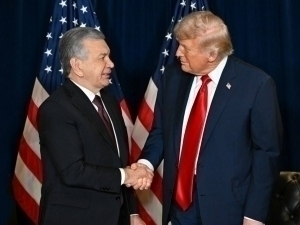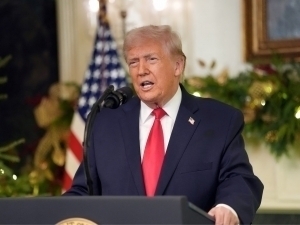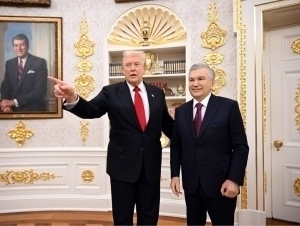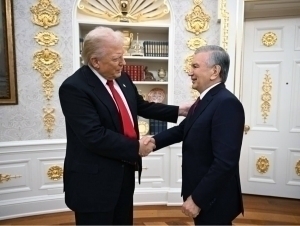Trump’s military offensive in Yemen: The battle against the Houthis begins
Review
−
19 March 10046 7 minutes
First, Hamas suffered serious losses in the conflict with Israel and ended the struggle with a truce. Then, Hezbollah faced similar setbacks. Meanwhile, the Assad regime in Syria also fell. Now, for four days, an air confrontation between the United States and the Houthis in Yemen has been ongoing.
In the past year and a half, the resistance movement under the supervision and patronage of Iran has been significantly weakened. Official Tehran has even been forced out of Syria, where it had maintained a strong presence for many years. This means its sphere of influence in the Middle East is shrinking, and its ability to project power is diminishing. Its influence over the Assad regime allowed Iran to operate freely in Syria, and its patronage of Hezbollah extended its reach into Lebanon. By supporting the Houthis on the southern tip of the Arabian Peninsula, Tehran had effectively taken control of Yemen.
The Houthis were the only Iranian proxy that had not yet been seriously attacked or suffered significant leadership losses. However, the setbacks suffered by Hamas and Hezbollah in recent months are now being mirrored by the Houthis. The conflict that began on March 15, following U.S. airstrikes on Houthi positions in central Yemen, ordered by Donald Trump, has continued unabated. The Houthis’ attacks on merchant ships in the Red Sea—carried out in solidarity with Hamas since 2023—had long been a focus of Trump’s attention. Over the following months, the confrontation between the United States and the Houthis escalated into armed conflict. Trump signed several documents in preparation for this, including reinstating the Houthis on the U.S. terrorist blacklist. Now, only military action remained.
Iran’s Last “Unharmed” Soldier
Hamas, which is estimated to receive $100-200 million in funding from Iran, lost 10,000 members during Israel’s invasion, which lasted a year and two months. Hamas is the only Sunni group in Iran’s network of resistance movements. Its key military leader, Mohammed Deif, as well as political figures Ismail Haniyeh and Yahya Sinwar, were killed in the Israeli offensive.
When it comes to losses, another Iranian proxy—Hezbollah in Lebanon—was particularly hard-hit. The group’s 32-year-old leader, Hassan Nasrallah, was killed on September 27, followed just a week later by his successor, Hashim Safi al-Din. In addition, Hezbollah saw the deaths of dozens of senior commanders, including Ibrahim Aqil and Abbas Nilforoushan, who had been sent from Iran to assist. Eventually, Hezbollah was forced to agree to a ceasefire with Israel.
Iran’s next proxy group, the Houthis, is a Yemeni Shiite movement officially known as Ansarullah. The group’s unofficial name, the Houthis, comes from its founder, Hussein Al-Houthi, who established the movement in the 1990s. The Houthis actively resist the official Yemeni government, Saudi Arabia, and its allies, while considering Israel their main enemy.
Organizationally, the Houthis are very similar to Hezbollah in Lebanon. Since 2014, they have controlled Yemen’s capital, Sanaa, and the northwestern part of the country—much like Hezbollah’s dominance in Beirut, southern Lebanon, and the Baalbek Valley.
Legal Preparation
During Trump’s first administration, the Houthis were designated as a terrorist organization. However, when Joe Biden took office, he removed them from the list, with then-Secretary of State Antony Blinken citing humanitarian reasons.
On January 22, 2025, Donald Trump reinstated the Houthis as a Foreign Terrorist Organization (FTO), a designation that took effect on March 4. Since 2023, with support from Iran’s Islamic Revolutionary Guard Corps, the Houthis have fired dozens of projectiles at U.S. Navy warships. The U.S. government document outlining the designation also referenced several past attacks, including those on Saudi Arabian airports in 2014-2015, an attack on the UAE in January 2022, and more than 300 missile strikes on Israel since October 2023.
Merchant Ships’ Nightmare
Following the escalation of the Gaza conflict, the Houthis warned they would target Israeli-linked ships and block the Red Sea and Bab al-Mandeb Strait access until the Israeli military operation in Gaza ended. Since November 2024, they have attacked numerous civilian ships in the Red Sea and the Gulf of Aden.
The Red Sea is one of the world’s most crucial maritime trade routes, facilitating the transport of oil, liquefied gas, and other goods. Due to Houthi attacks, nearly all major shipping companies have rerouted their vessels to avoid the region, leading to longer and more expensive journeys.
Since November 2023, the Houthis have launched 190 attacks in the Red Sea, according to the U.S. Congress. While the group claims to be targeting Israeli-affiliated ships, not all vessels hit have had links to Israel.
Trump-Led Strikes
On March 15, the U.S. Armed Forces, under orders from President Trump, launched mass airstrikes on Houthi-controlled areas in Yemen.
“Today, I have directed the United States military to take decisive and forceful military action against the Houthi terrorists in Yemen. They are waging a relentless campaign of piracy, violence, and terrorism against American and foreign ships, aircraft, and drones. I am telling the terrorist Houthis: Your time is up. You must cease your attacks. Otherwise, you will face the likes of hell you have never experienced,” the U.S. President announced.
In response, Houthi leader Abdulmalik al-Houthi stated that the new U.S. attack would only strengthen their military capabilities. He warned that U.S. warships and aircraft would now be legitimate targets.
The Airstrikes Begin
According to Al Hadath TV, the U.S. Armed Forces launched their first strikes at 7:00 p.m. on March 15, with bombardments continuing for 10 hours. The attacks targeted positions in Sanaa, Al-Bayda, Al-Hodeidah, Saada, Hajjah, and Marib.
However, the Houthis claimed that civilian infrastructure was also hit. The Yemeni Ministry of Health reported 31 deaths and more than 100 injuries in the initial wave of strikes. The Houthis accused the U.S. and Britain of launching an “evil” aggression against the Yemeni population.
Before these large-scale airstrikes, the U.S. and Britain had already formed a military coalition against the Houthis.
Trump’s Warning to Iran
Trump also issued a direct warning to Iran, calling on Tehran to halt its support for the Houthis and warning that Washington would hold Iran “fully accountable” for further escalation.
Despite the airstrikes, The New York Times, citing U.S. officials, reported that Trump has not yet approved a large-scale military operation against the Houthis. While his national security advisers have drafted a plan for an extended bombing campaign against underground Houthi arsenals, Trump—who had pledged to avoid military interventions—has so far refrained from escalating further.
The Conflict Continues
On March 17, the U.S. launched six additional airstrikes in Hodeidah and Jawf provinces. According to Al Masirah TV, U.S. fighter jets targeted a cotton processing factory in Zebid (Hodeidah) and a government compound in Hazm (Jawf).
In retaliation, the Houthis claimed to have struck the USS Harry Truman aircraft carrier three times within 48 hours. They also launched a cruise missile and four drones at a U.S. destroyer.
With the U.S. continuing its airstrikes, the conflict between Washington and the Houthis appears to be escalating. Whether Trump will commit to a prolonged military campaign remains uncertain. However, the strikes signal a major shift in U.S. policy, posing a direct challenge to Iran’s last remaining proxy force in the Middle East.
Live
All



